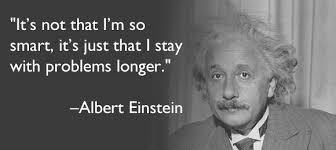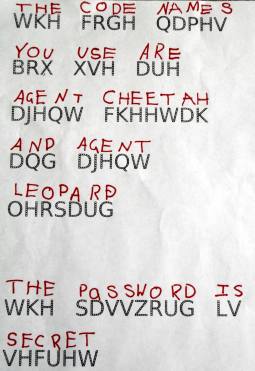Hannah and Casey were a couple of this year’s pupils; they were a pleasure to work with and they both enjoyed their sessions. Hannah had found changing schools – indeed, she’d had to change continents – a real problem, but I think she found it easier to be in a group with just one other pupil, while Casey reminded me of one of those toys with an extra-strength battery – when other pupils would have needed to take things easy for a while, she just kept on going.
In terms of attainment they’re not brilliant – both bang in the middle of their year – the teacher had asked me to concentrate upon building confidence and giving them experience in following written instructions. We’d all enjoyed the lessons so much that for their last two sessions I devised a suite of activities that would let them be secret agents. Several of the teachers were pleased to adopt new identities for the occasion, and Hannah and Casey had to follow routes round the school to locate Agent Panther and others to receive the sealed envelopes for their assignments. The assignments themselves were pretty routine and of the sort they’ll meet in their national Tests – interpreting a train timetable, or buying items from a snack bar and working out the total cost and the change – though of course they were a lot more fun as part of their mission than they might be in a test paper. Still, they met the target of confidence-building and interpreting written instructions in an agreeable way.
But one thing will really stay with me for a long while, and that was the way they did their introductory activity. I’d given them their instruction via a message which they had to decode; I told them there were three clues on offer, but if they were to need more than three they’d fail their mission.
Initially they had no really idea how to go about things, so they took their first clue, and I told them that in any passage of written English the most common letter is very likely to be E. The whole task was very unfamiliar to them and they were finding it very hard, so they asked for their second clue; I suggested they check to see if there was a three-letter word ending in E in the message, because it was very likely the message would contain THE somewhere.
So they now had three letters, T, H, and E, and could being to make progress more comfortably. The word *HEET*H jumped out at them – by great good fortune I’d included Cheetah as one of their codenames, so they now had two more letters.
They continued from here and it took them another 20 minutes or so. (I’d actually made the code as a “Caesar cipher”, so that discovering that E had been enciphered as H also meant that F, G, etc had been enciphered as I, J, etc, but they never spotted this and it wasn’t necessary to know that in any case.) Progress came in fits and starts, and sometimes they went up a blind alley and had to retract. Several times I pointed out that they still had the chance of a third clue, and several times they ignored me. Eventually Casey looked me in the eye and accused me “You’re trying to tempt us, aren’t you?”
Yes, I was, but I was absolutely delighted that I didn’t succeed. They’d found it very hard indeed to break into the activity and the typical reaction of pupils would have been to give up, or at the very least to demand their third clue. While I’d seen the three clues as an offer of a support – but an offer which made clear the support would not be unlimited – they were seeing the offer rather differently. In their interpretation, three clues had become a yardstick to measure themselves against, and they were challenging themselves to do better and to solve the problem in two clues only.
There have been a few occasions when I’ve seen children work far above their normal capacities. We used to take children on a residential trip and spend the time doing exploratory mathematics; on occasion I’d order them to stop at 6pm because it was time for dinner. Another time was when the Rubik Cube appeared; overnight schools were full of perplexed teachers with the most unlikely pupils showing them how to solve the cube.
In a small way, Casey and Hannah were doing much the same and were going beyond the limits all three of us might have expected. I once did a set of video-lectures in which I’d introduce a problem and we’d do a follow-up two or three weeks later after the pupils had had the chance to explore the problems for themselves. I titled the session “I’m Not Smart” after a quote from Albert Einstein. When you can find the right stimulus pupils do indeed stick at problems longer, and that was exactly what Hannah and Casey had done.

The very last thing I did with them was to tell them how well they’d done and give them a written copy of the quote from Duke Ellington that Iva Sallay drew our attention to. They were pleased and rather touched; I’ve a fond hope than in fifty years from now they’ll be showing them to tell their grandchildren how when you really persevere the sky’s the limit.
.
.


So much fun, so much accomplished, and so much confidence build. Well done!
There was one really funny episode when they misinterpreted an instruction and approached a member of staff who wasn’t in on the scheme at all. They kept on asking this bemused lady if she was Agent Lion and then repeatedly tried the password, which only confused things more. I was hiding round the corner and was in stitches.
It’s good that you had some fun with it as well!